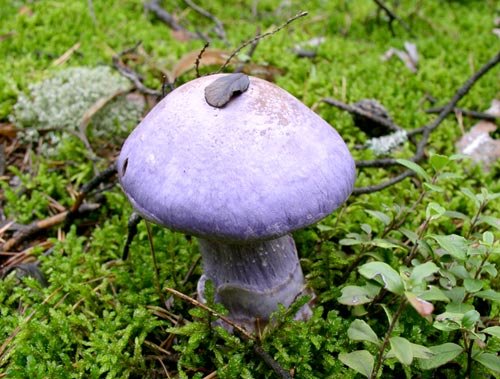Goat web (Cortinarius traganus)
- Dabeş: Basidiomycota (Basidiomycetes)
- Dabeşkirin: Agaricomycotina (Agaricomycetes)
- Çîn: Agaricomycetes (Agaricomycetes)
- Binçalak: Agaricomycetidae (Agaricomycetes)
- Rêzkirin: Agaricales (Agarîk an Lamellar)
- Malbat: Cortinariaceae (Spiderwebs)
- Cins: Cortinarius (Spiderweb)
- Awa: Cortinarius traganus (Goat webweed)

tevna bizinê, an bîhnxweş (T. Cortinarius traganus) – an inedible mushroom of the genus Cobweb (lat. Cortinarius).
Goat’s cobweb hat:
Quite large (6-12 cm in diameter), regular round shape, in young mushrooms hemispherical or cushion-shaped, with neatly tucked edges, then gradually opens, maintaining a smooth bulge in the center. The surface is dry, velvety, the color is saturated violet-gray, in youth it is closer to violet, with age it tends more towards bluish. The flesh is very thick, greyish-violet, with a very strong unpleasant (and by the description of many, disgusting) “chemical” smell, reminiscent, according to the description of many, of acetylene or an ordinary goat.
Tomar:
Frequent, adherent, at the very beginning of development, the color is close to the hat, but very soon their color changes to brown-rusty, as the fungus grows, it only thickens. In young specimens, the plates are tightly covered with a well-defined cobweb cover of a beautiful purple color.
Toza Sporê:
Qehweyî rizyayî.
Goat cobweb leg:
In youth, thick and short, with a massive tuberous thickening, as it develops, it gradually becomes cylindrical and even (height 6-10 cm, thickness 1-3 cm); similar in color to the hat, but lighter. Abundantly covered with purple remnants of cortina, on which, as the maturing spores scatter, beautiful red spots and stripes appear.
Belavbûn:
Goat web is found from mid-July to early October in coniferous and mixed forests, usually with pine; like many cobwebs growing in similar conditions, it prefers moist, mossy places.
Cureyên wekhev:
There are a lot of purple cobwebs. From the rare Cortinarius violaceus, the goat’s cobweb reliably differs in rusty (not purple) plates, from the white-violet cobweb (Cortinarius alboviolaceus) by its rich color and brighter and more abundant cortina, from many other similar, but not so well-known blue cobwebs – by a powerful disgusting smell. The most difficult thing is probably to distinguish Cortinarius traganus from the close and similar camphor cobweb (Cortinarius camphoratus). It also smells strongly and unpleasantly, but more like camphor than goat.
Separately, it must be said about the differences between the goat web and the purple row (Lepista nuda). They say some are confused. So if your row has a cobweb cover, the plates are rusty brown, and it smells loud and disgusting, think about it – what if something is wrong here?









